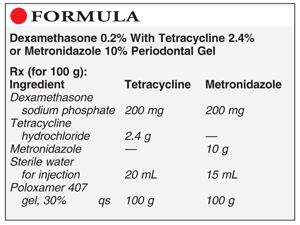US Pharm. 2009;34(3):42-43.

Method of Preparation: Calculate the required quantity of each ingredient for the total amount to be prepared. Accurately weigh/measure each ingredient. Depending upon which agent is being used, disperse the tetracycline hydrochloride (HCl) in the sterile water for injection (SWI) or mix the metronidazole in the SWI, forming a paste. Add the dexamethasone sodium phosphate to about 40 g of the poloxamer gel. Incorporate the previously made antibiotic and mix well. Add sufficient poloxamer gel to final weight; mix well. Package and label.
Use: This preparation has been used in the treatment of gingivitis and periodontitis.
Packaging: Package in prefilled, sterile, disposable syringes.
Labeling: For professional use only by topical application. Store in the refrigerator. Protect from light.
Stability: No specific studies of these preparations have been reported. A beyond-use date of 14 days can be used when the preparation is stored in the refrigerator.1 This is a nonsterile gel.
Discussion: Gingivitis and periodontitis affect the gingival, subgingival, periodontal, and adjacent tissues of the oral cavity. Various antibiotics and antibacterials (tetracycline, minocycline, clindamycin, metronidazole, chlorhexidine) have been used to treat these conditions.2-4 Oral rinses and gels are effective means of delivering antibiotics and antibacterials to the gingival crevice. Gels can be applied professionally and remain in contact with the diseased area longer than rinses do. Poloxamer (Pluronic) gels are biocompatible and bioadhesive; they are eliminated through routine catabolic pathways, decreasing the risk of irritation or allergic reaction.
When prefilled in sterile, disposable syringes, the gel can easily be administered into the gingival pocket. The poloxamer gel is a reverse-thermal gel; it is fluid at cold temperatures and forms a viscous gel at higher temperatures. If kept cool, therefore, the gel flows easily into the pocket, where it becomes more viscous as it warms up and slows the rate at which the gel is dissolved and removed from the pocket; this means a more prolonged effect of the entrapped drug.
Dexamethasone sodium phosphate (C22H28FNa2O8P, MW 516.40) occurs as a white or slightly yellow crystalline powder. It is odorless or has a slight odor of alcohol. Very hygroscopic, it is freely soluble in water and slightly soluble in alcohol. The injection has a pH between 7.0 and 8.5, and it contains not more than 31.3 USP endotoxin units per mg dexamethasone phosphate. Dexamethasone is an anti-inflammatory and immunosuppressant agent with minimal mineralocorticoid properties.1,5
Tetracycline (C22H24N2O8, MW 44.43) and tetracycline HCl (C22H24N2O8.HCl, MW 480.90) are antibiotics that occur as yellow crystalline powder; the base form is soluble in water to the extent of 0.4 mg/mL and alcohol 20 mg/mL, and the HCl salt to the extent of 100 mg/mL in water and 10 mg/mL in alcohol. Tetracycline products are stable in air, but darken on exposure to strong sunlight in moist air; they should be stored in tight, light-resistant containers.1,6
Metronidazole (C6H9N3O3, MW 171.15) is a synthetic, nitroimidazole-derivative antibacterial and antiprotozoal agent that also has anti-inflammatory effects. It is available in base and salt form. Metronidazole occurs as white to pale-yellow crystals or as a crystalline powder. It is sparingly soluble in water and in alcohol. It is generally stable in air, but may darken upon exposure to light.1,5
Poloxamer 407 (MW 9,840-14,600, Pluronic F127) is one of a series of closely related block copolymers of ethylene oxide and propylene oxide. It occurs as white, waxy, free-flowing granules or powder and is practically odorless and tasteless. It is freely soluble in water and alcohol; a 2.5% w/v aqueous solution has a pH in the range of 6.0 to 7.4, and it melts at about 56°C.7
SWI is water for injection that has been sterilized and suitably packaged; it contains no added substances. It is miscible with most polar solvents and is chemically stable in all physical states (ice, liquid, and steam).8
REFERENCES
1. US Pharmacopeial Convention, Inc. USP Pharmacists' Pharmacopeia. Rockville, MD: US Pharmacopeial Convention, Inc; 2005:408-413,1434,1448,1464.
2. Kornman K. Controlled-release local delivery antimicrobials in periodontics: prospects for the future. J Periodontol. 1993;64:782-791.
3. Van der Ouderaa FJ. Anti-plaque agents. Rationale and prospects for prevention of gingivitis and periodontal disease. J Clin Periodontol. 1991;18:447-454.
4. Esposito E, Carotta V, Scabbia A, et al. Comparative analysis of tetracycline-containing dental gels: poloxamer- and monoglyceride-based formulations. Int J Pharm. 1996;142:9-23.
5. McEvoy GK, ed. AHFS Drug Information. Bethesda, MD: American Society of Health-System Pharmacists; 2008:3102-3103,3495-3500.
6. Reynolds JEF, ed. Martindale: The Extra Pharmacopoeia. 30th ed. London, England: Pharmaceutical Press; 1993:212-216.
7. Collett JH. Poloxamer. In: Rowe RC, Sheskey PJ, Owen SC, eds. Handbook of Pharmaceutical Excipients. 5th ed. Washington, DC: American Pharmaceutical Association; 2006:535-538.
8. Galichet LY. Water. In: Rowe RC, Sheskey PJ, Owen SC, eds. Handbook of Pharmaceutical Excipients. 5th ed. Washington, DC: American Pharmaceutical Association; 2006:802-806.





